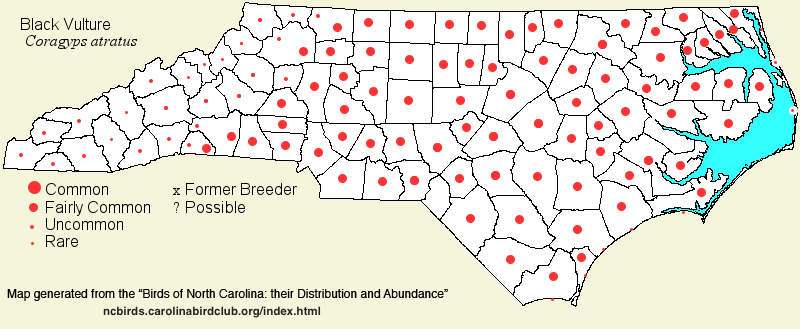 |  |
|
Black Vulture - Coragyps atratus CATHARTIDAE Members: | Search Common: Search Scientific: |
|
|
|||||||
| General Comments | Though the Black Vulture is one of the most abundant and widespread "raptors" in the New World, in North Carolina populations are not overly large and showed a strong enough decline in the 1970's and 1980's that it was State listed as Special Concern. This decline was likely due to both a loss of large livestock farms/operations and stronger laws regarding burial of animal carcasses, as this species feeds prominently on larger mammal carcasses. It has always been less numerous than its larger cousin, the Turkey Vulture; however, numbers of Black Vultures seem to have leveled off or slightly increased since the 1980's, though it is hardly a common bird anywhere in the state, and it has always been relatively scarce in the mountains. By 2008, the species was taken off the State protected (i.e., Special Concern) list. The species strongly favors areas with considerable livestock, and thus is most often seen near pastures and feed lots, as well as landfills; however, most birds are observed overhead, soaring over most any type of habitat, except highly urban areas. They nest in old barns and sheds, in caves and rock ledges, and in dense vine tangles/thickets. | ||||||
| Breeding Status | Breeder | ||||||
| NC BRC List | Definitive | ||||||
| State Status | |||||||
| U.S. Status | |||||||
| State Rank | S5 | ||||||
| Global Rank | G5 | ||||||
| Coastal Plain | Permanent resident, mostly non-migratory but with some local movements; slightly increasing. Fairly common over most of the province; most numerous in the Roanoke River area, but scarce (uncommon) in the Sandhills. Also scarce near the coast, and largely absent on coastal islands. In fact, Hatteras Island had its first record in 2006. Peak counts: 200, along the Roanoke River (Bertie), 11 Mar 1976. | ||||||
| Piedmont | Permanent resident, with barely noticeable local movements; slightly increasing. Uncommon to fairly common, but scarce near urban and suburban areas. Somewhat less numerous in the foothills, but by no means rare in these areas. Peak counts: | ||||||
| Mountains | Permanent resident, with some migratory movements; increasing?. Mostly rare to uncommon in lower elevations (below 3,000 feet), and rare from about 3,000-3,500 feet. Some birds leave the mountains in the winter months, when it is rare over much or most of the province. Small numbers are counted from fall hawk watch stations, presumably of southward migrating birds. Peak counts: 75, WTP along NC 191 in Henderson, 12 Jan 2014. | ||||||
| Finding Tips |
In a normal day of birding downstate, you are likely to see it once every day or two, if reasonably sunny. Your chances are best where there are cattle farms. *** | ||||||
| Attribution | LeGrand[2021-08-04], LeGrand[2014-08-12], LeGrand[2012-05-19] | ||||||
| NC Map Map depicts all counties with a report (transient or resident) for the species. | Click on county for list of all known species. |
| NC Breeding Season Map Map depicts assumed breeding season abundance for the species. |  |